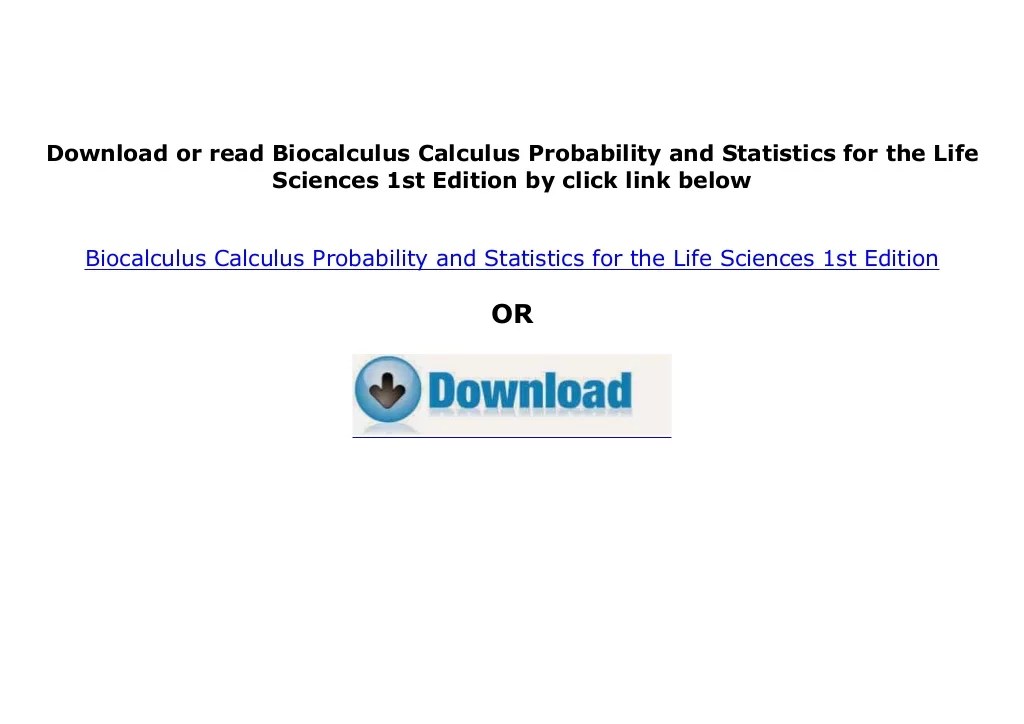Biocalculus calculus probability and statistics for the life sciences, an interdisciplinary field that integrates mathematical concepts with biological principles, offers a powerful toolkit for understanding and modeling complex biological systems. This comprehensive guide delves into the fundamental concepts, applications, and ethical considerations of biocalculus, providing a solid foundation for researchers and students alike.
From population modeling to data analysis, biocalculus empowers scientists to explore the intricacies of life. Its mathematical rigor and computational methods enable the development of predictive models, unraveling biological mysteries and driving advancements in medicine, ecology, and biotechnology.
1. Introduction: Biocalculus Calculus Probability And Statistics For The Life Sciences

Biocalculus is an interdisciplinary field that combines the principles of calculus, probability, and statistics to analyze and model biological systems. Calculus provides a framework for understanding continuous change, while probability and statistics enable us to quantify uncertainty and make predictions about future events.
Together, these mathematical tools provide a powerful approach to solving complex problems in the life sciences.
Biocalculus has a wide range of applications in biology, including population modeling, evolutionary biology, epidemiology, and drug discovery. It allows researchers to study the dynamics of biological systems, predict their behavior, and make informed decisions about their management.
2. Mathematical Foundations
The mathematical foundations of biocalculus include the fundamental concepts of calculus, probability, and statistics. Calculus provides a framework for understanding continuous change, including the concepts of derivatives, integrals, and differential equations. Probability and statistics provide a framework for quantifying uncertainty and making predictions about future events, including the concepts of probability distributions, statistical inference, and hypothesis testing.
In biocalculus, these mathematical concepts are applied to a wide range of biological problems. For example, derivatives can be used to model the rate of change of a population, integrals can be used to calculate the total amount of a substance in a system, and probability distributions can be used to model the distribution of a trait in a population.
3. Applications in Biology
Biocalculus has a wide range of applications in biology, including population modeling, evolutionary biology, epidemiology, and drug discovery. In population modeling, biocalculus is used to study the dynamics of populations, including their growth, decline, and interactions with other species. In evolutionary biology, biocalculus is used to study the evolution of traits over time, including the effects of natural selection and genetic drift.
In epidemiology, biocalculus is used to study the spread of infectious diseases, including the development of vaccines and treatment strategies. In drug discovery, biocalculus is used to model the effects of drugs on biological systems, including their efficacy and safety.
4. Computational Methods

Computational methods play an important role in biocalculus. Computers can be used to perform complex calculations, simulate biological systems, and visualize data. This allows researchers to tackle problems that would be impossible to solve by hand. For example, computers can be used to simulate the spread of an infectious disease in a population, or to model the evolution of a trait over time.
5. Ethical Considerations
The use of mathematical models in the life sciences has important ethical implications. It is important to ensure that models are accurate and reliable, and that they are used responsibly. For example, it is important to consider the potential consequences of using a model to make decisions about public health or environmental policy.
6. Future Directions

Biocalculus is a rapidly growing field, with new applications being developed all the time. In the future, biocalculus is likely to play an increasingly important role in the life sciences. For example, biocalculus could be used to develop new treatments for diseases, to design new drugs, or to predict the effects of climate change on ecosystems.
FAQ Compilation
What is biocalculus?
Biocalculus is an interdisciplinary field that combines mathematical concepts with biological principles to study and model biological systems.
How is biocalculus used in the life sciences?
Biocalculus is used in a wide range of applications in the life sciences, including population modeling, data analysis, and computational simulations.
What are the ethical considerations in using biocalculus?
Ethical considerations in using biocalculus include responsible data collection and analysis, as well as the potential impact of mathematical models on biological systems.